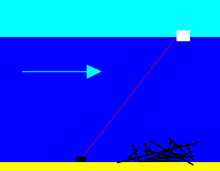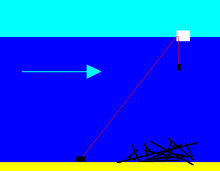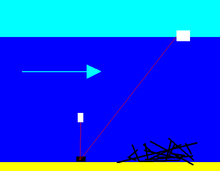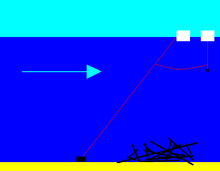- Diving shot
-
A diving shot is an item of diving equipment consisting of a weight, a line and a buoy. The weight is dropped on the dive site. The line connects the weight and the buoy and is used by divers to move between the surface and the dive site more safely and more easily.
Contents
Purposes
The shot has several purposes. The line is useful for divers in conditions of low visibility or strong tides where underwater navigation between the surface and the dive site is difficult or on deep dives where a navigation error would dramatically reduce useful underwater time.[1] Divers can use the line to help buoyancy control, to ease long decompression stops and to prevent drift when ascending in a current.
The buoy marks the dive site for the people on the surface, who are generally on the dive boat, who provide safety cover for the divers. This helps them focus on the place where the divers are likely to return to the surface and helps them return to the dive site more quickly after the boat has moved away from the site.
Construction
Typically the weight is lead and weighs around 20 kg (44 lb). To prevent the assembly sinking and being lost, the buoy should provide more buoyancy than is required to make the complete system float. For example, if a 20 kg/44 lb weight is used, the buoy must provide more than 20 kg buoyancy: it needs to be at least 20 litres/4.4 gallons in volume.
The line should be longer than the depth of the dive site and at least 10 mm (0.4 inch) in diameter. A thick line is used because the shot weight is often lifted by pulling the line by hand and the pressure of a thin line causes pain and damage to the skin and the hands.
Floating line, such as polypropylene, although cheap, can foul the propellers of boats if it is allowed to accumulate near the surface. There are several ways of avoiding this:
- coil the excess line after deployment
- use a "top tensioning" arrangement: the line runs freely through a ring on the buoy and is weighted at the top end by a small weight
- use a "bottom tensioning" arrangement: the line runs freely through a ring on the weight and is lifted at the bottom end by a small, rigid buoy
A "lazy shot" is a second shot which is connected to the first shot at a depth deeper than the deepest decompression stop. It is used for decompression and frees the main shot for other divers. The lazy shot's line does not need to be longer than the decompression depth and it only needs a weight heavy enough to provide diver buoyancy control.[2]
Using shots
The shot is deployed, generally from a boat, after the dive site is located using position fixing such as GPS and an echo sounder.
Shots are more difficult to use in strong currents. The weight may drag along the seabed especially if the divers pull on the line as they descend. To avoid this the shot is often positioned upstream of an obstruction at the dive site so the obstruction prevents it dragging. A further problem is caused by diving at slack water; the direction of the current reverses during slack, so although the weight may be securely up current of the obstruction before slack, after the tide turns the weight is down current of the obstruction and may drag.
At the surface, the direction of the current is indicated by three signs at the buoy: the direction of the line to the weight, a "horseshoe" bow-wave on the front of the buoy and a wake at the back of the buoy.
Sometimes, two buoys are used at the surface. The second buoy can further indicate the strength and the direction of the current or be misleading because it may indicate the direction of the wind. A second buoy can be used to provide additional buoyancy if one buoy is dragged underwater.
Sometimes the line, once at the dive site on the seabed, is tied to the dive site to guard against the weight dragging away from the site.[3] The line itself may be tied to the dive site or a thin "waster" line may attach the strong line to the dive site. If a waster is used, the boat at the surface can be used to break the waster at the end of diving before the shot is lifted. If the main line is attached to the dive site, the divers must untie it before ascending at the end of diving otherwise they lose their shot.
In a current, the buoy may be dragged under the surface by water resistance of the divers holding the line as they ascend and reach shallow water. If this happens divers will not want to descend with the buoy and will prefer to release the shot line and be swept away from the shot. In strong currents divers often decompress on decompression buoys instead of using a shot.
Sometimes, a lifting bag is attached to the weight and used to help raise the weight at the end of the dive.
See also
- Decompression buoy
- Decompression trapeze
References
- ^ http://www.divemagazine.co.uk/news/article.asp?UAN=1094 Dive Magazine's How to Put Down a Shot Line
- ^ http://www.divingandmarinecentre.com/downloads/shotsanddecorigs.pdf Diving and Marine Centre Shots and Deco rigs
- ^ http://www.canterburydivers.org.uk/diving_procedures.html Canterbury Divers Diving Procedures
Categories:
Wikimedia Foundation. 2010.




